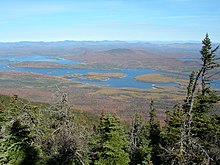Flagstaff (Maine)
Flagstaff is a former plantation in Somerset County of the state of Maine in the United States . Flagstaff was near Eustis and Rangeley .
The plantation was given up in 1949 along with the neighboring Bigelow , Dead River and Carrying Place plantations in favor of an enlargement of Flagstaff Lake . With the Long Falls Dam , a reservoir was built, which was mainly created for the use of hydropower .
Benedict Arnold was the first European to reach the area in 1775 during his campaign against Canada en route to Québec. He erected a flagpole in the area, which later gave the town its name Flagstaff .
The first settlers settled in the early 19th century. They lived from agriculture and forestry and used the water energy of the Flagstaff Pond. The first shot mills and sawmills were built in the 1840s. After the expansion of the Flagstaff Pond in the 1940s was decided to buy the land against the condition, Walter Wyman and his company, Central Maine Power, acquired the land in the Dead River Valley. Many residents moved to Eustis, and the cemetery was reburied there, as was the Flagstaff Memorial Chapel. Sometimes they could take their houses with them. The organizational form of the plantation was abolished in 1950 and the former plantation was flooded after the construction of the Long Falls Dam.
Below
Slaid Cleaves
( Please note copyrights )
Slaid Cleaves addressed the destruction of the settlement in his song Below in 2004, which he released on the album Wishbones. Flagstaff is not mentioned by name, but the Dead River and the location of the settlement are mentioned.
Individual evidence
- ^ A b The Flooding of Flagstaff - Dead River Area Historical Society. In: deadriverareahistoricalsociety.me. Retrieved May 30, 2020 .


